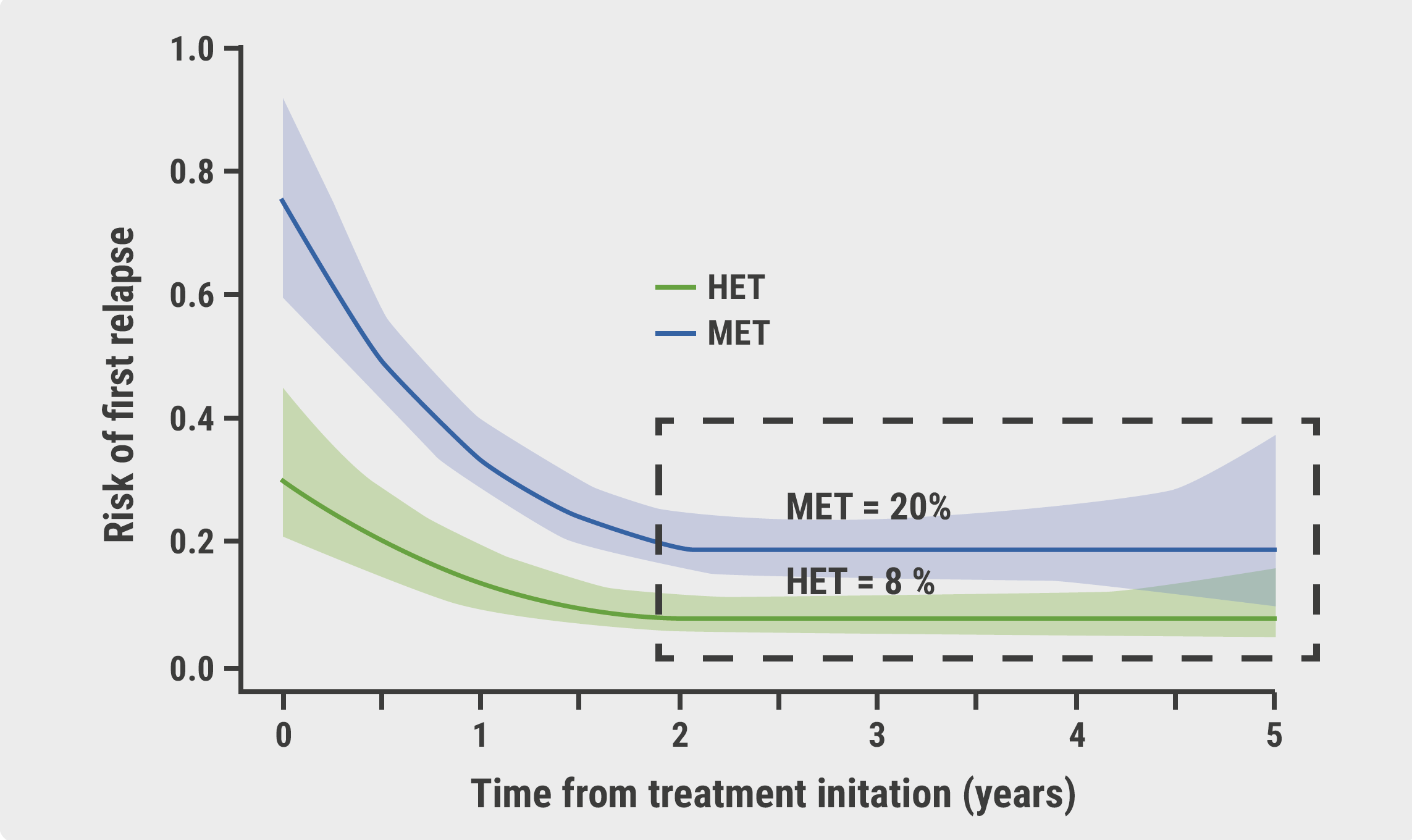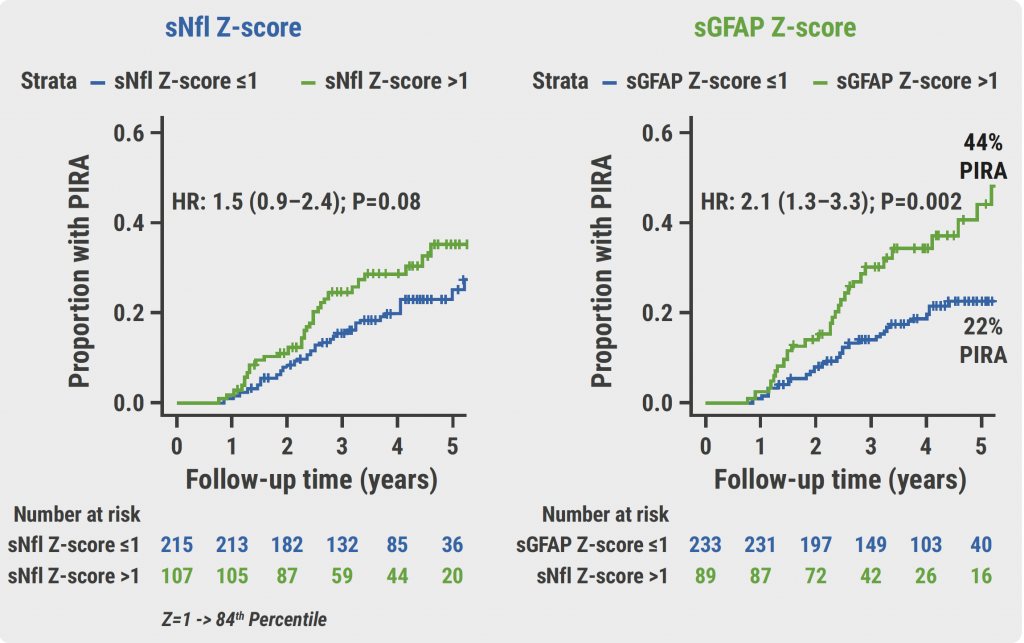https://doi.org/10.55788/3f40504c
“The common thing to do in paediatric-onset MS is still to escalate therapy and thus to start with a MET” [1], argued Dr Benallegue. In a retrospective observational study (NCT02889965), Dr Benallegue and colleagues compared the real-world effectiveness of HET and MET on disease activity and evaluated treatment cessation [2]. They used data from 36 French MS expert centres participating in the French MS registry. The study population consisted of 530 treatment-naïve patients <18 years of age with relapsing-remitting MS who initiated MET (n=422) or HET (n=108) between 2010 and 2022. For data analysis, an innovative parametric time-to-event model was used to estimate the dynamics of event rate adjusting for confounders.
The results showed that after a median follow-up of 5.8 years, both HET and MET reduced the risk of first relapse during the first 2 years of treatment. Over a 5-year period, HET reduced this risk of first relapse by 54% compared with MET (adjusted HR 0.46; 95% CI 0.31–0.67; P<0.001). In these first 5 years, the annual relapse risk was 20% in the MET group and 8% in the HET group (see Figure). These results were confirmed by a 66% reduction of new T2 and gadolinium-enhancing lesions with HET at 2 years, measured with MRI in 300 patients (adjusted OR 0.34; 95% CI 0.18–0.66; P=0.001). There was no difference in Expanded Disability Status Scale (EDSS) score progression.
Figure: Primary outcome: time to first relapse [2]

HET, high-efficacy therapy; MET, moderate-efficacy therapy.
MET was associated with a 6-fold higher risk of discontinuation within 2 years (HR 5.97; 95% CI 2.92–12.20), mostly due to inefficacy or intolerance. At 5 years, 86.1% of patients had discontinued MET and 50.7% discontinued HET. Overall, a HET-strategy was sustained in 92 (85.2%) patients; 257 (60.9%) patients on MET switched to HET.
- Henderson M, et al. JAMA Neurol. 2023;80:860–867.
- Benallegue N, et al. Highly effective therapies as first-line treatments for pediatric onset multiple sclerosis in a French nationwide cohort. O141, MSMilan 2023, 11–13 October, Milan, Italy.
Copyright ©2023 Medicom Medical Publishers
Posted on
Previous Article
« New insights into the contribution of EBV to MS pathogenesis Next Article
Oral glycolipid shows promise in the treatment of MS, especially SPMS »
« New insights into the contribution of EBV to MS pathogenesis Next Article
Oral glycolipid shows promise in the treatment of MS, especially SPMS »
Table of Contents: MSMilan 2023
Featured articles
Letter from the Editor
Real-world data supports ocrelizumab prior to conception
Progressive MS
Early initiation of highly active treatment associated with a lower risk of SPMS
Ocrelizumab more effective than interferon/glatiramer acetate in older MS patients
Paediatric MS
Prioritising high efficacy therapies in children with MS
Omega-3 polyunsaturated fatty acids associated with lower risk of MS activity
NMOSD & MOGAD
An update on evolving treatment algorithms for NMOSD and MOGAD
Women’s Health
Rate of grey matter brain atrophy accelerates after menopause
Real-world data supports ocrelizumab prior to conception
Miscellaneous
New insights into the contribution of EBV to MS pathogenesis
COVID-19 infection associated with higher MS relapse rate
Telerehabilitation effective in improving MS symptoms in patients with moderate disability
Curing MS
Understanding what an MS cure means and what it takes
Prodromal MS
Progressive brain tissue loss precedes the onset of clinical MS by years
Sickness absence rate increases years before clinical onset of MS
Treatment Trials and MS Strategies
Early intensive treatment enhances long-term clinical outcomes
Oral glycolipid shows promise in the treatment of MS, especially SPMS
Fenebrutinib shows rapid reduction of new Gd+ T1 lesions
Challenges of de-escalation versus discontinuation of highly effective DMTs in older MS patients
Biomarkers & Imaging
χ-separation can assess the effects of tissue destruction in early MS lesions
High sGFAP levels are associated with disease progression, independent of NfL or relapse activity
Broad rim lesions correlate with a rapidly progressive MS phenotype
Smouldering inflammation detectable even in the earliest stages of MS
Related Articles
November 8, 2019
Novel ways to assess MS

© 2024 Medicom Medical Publishers. All rights reserved. Terms and Conditions | Privacy Policy
HEAD OFFICE
Laarderhoogtweg 25
1101 EB Amsterdam
The Netherlands
T: +31 85 4012 560
E: publishers@medicom-publishers.com

